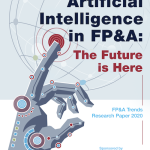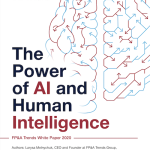The result is this paper that covers the elements crucial for any organisation approaching AI or ML for the first time including challenges, methods...

Introduction: A New Era for FP&A
In today's fast-paced corporate world, Financial Planning and Analysis (FP&A) teams are more than just number crunchers. They are pivotal in driving business decisions, identifying risks and opportunities, and shaping future strategies. However, the reality for most FP&A teams with finance Business Partnering is a heavy focus on historical data analysis and reporting, consuming up to 85% of their time.1
FP&A is often limited by tools and still heavily relies on manual work for routine recurring activities such as budgeting, forecasting, variance analysis, and reporting. Recent advances in Artificial Intelligence (AI), particularly Large Language Models (LLMs) like BloombergGPT, demonstrated use cases for LLMs in corporate finance.2
This article explores how LLMs could improve FP&A productivity and redefine finance Business Partnering.
The Emergence of AI and LLMs
AI has long been part of the finance technology stack. The scope of its applications ranges from automated invoice to purchase order matching via text recognition in the accounts payable function to forecasting sales via Machine Learning (ML) algorithms in the FP&A function.
The introduction of LLMs, including OpenAI's GPT and Google's BERT, marks a significant advancement in the field of Generative AI. These models, trained on extensive textual data, have evolved rapidly, significantly enhancing their language understanding and generation capabilities.
Google's BERT (Bidirectional Encoder Representations from Transformers) was a pioneering model, introducing the power of bidirectional context to language understanding and dramatically improving tasks like sentiment analysis and question answering.3 Following BERT, Google's T5 (Text-to-Text Transfer Transformer) expanded the scope, reframing various NLP tasks into a unified text-to-text format, showcasing the model's versatility.
OpenAI's GPT series (Generative Pre-trained Transformer) marked a shift toward models capable of generating coherent and contextually relevant text, with each iteration showing remarkable improvements in text generation capabilities, understanding, and scalability.4 The latest in this lineage, Meta AI's LLaMA 2 models, continue to push the boundaries and were released as open-source models.5
While LLMs are very popular and improve month-over-month, it is essential to note that current technology has limitations, such as hallucinations.6 The correct model selection and implementation for the specific use case is critical.
The Impact of LLMs on FP&A Efficiency
Data quality and insights are a top priority for FP&A. FP&A teams spend a significant chunk of time on manual work such as data collection, quality reviews, and financial analysis preparation using spreadsheets that can lead to multiple versions and data inaccuracies.
LLMs enable financial analysts to interact with financial data via natural language, accelerating FP&A analytics work, especially when LLMs are connected to ERP, CRM, and other finance feeder systems. Financial professionals can quickly and efficiently analyse complex big data without knowing programming languages like SQL.
Furthermore, financial analysts can use LLMs to detect deviations and unusual patterns in financial data. Use cases include P&L plan to actual variance analysis in corporate FP&A and cohort analysis in sales finance. This anomaly detection saves time and enhances the accuracy and depth of financial reports and insights.
FP&A teams often work manually on data collection and aggregation from ERP, CRM, and other systems to gather information required for processes and reports. LLMs enable automated data aggregation and mapping, which can speed up these processes.
Financial reporting is mostly distributed to stakeholders with presentations and dashboards using popular general-purpose Business Intelligence (BI) tools. LLMs can significantly reduce the effort to prepare dashboards, charts, and illustrations for financial reporting compared to traditional drag-and-drop tools.
To summarise, LLMs can eliminate a significant chunk of manual work related to routine recurring activities in FP&A. As a result, FP&A teams can focus more on providing strategic insights and collaborating with business units.
Redefining Finance Business Partnering with AI
The traditional approach to FP&A has been gradually shifting towards more democratised access to financial data and analytics. FP&A teams established self-service use of financial data by implementing dashboards and Business Intelligence systems to meet increased business expectations on financial transparency and insights.
LLMs enable FP&A teams to accelerate this shift by providing stakeholders with instant, intuitive access to financial insights. Business users can directly ask the LLM in plain language and immediately get the information they need, bypassing the cumbersome process of navigating through dashboards and reports. This true self-service also relieves FP&A teams from the pressure of instantly providing real-time information.
Instead of preparing dashboards and data gathering, FP&A finance Business Partners can build on LLMs and provide actionable insights to business leaders. LLMs are more flexible than Business Intelligence systems. For example, it is easy to create a specific report using natural language for a particular business unit in addition to standard reporting.
Enhanced FP&A Reporting and Analysis with LLMs
FP&A teams that deploy LLMs gather insights from the stakeholders' questions to the LLM. This knowledge improves FP&A's understanding of the organisation's specific needs and enables FP&A to support business units better.
LLMs paired with knowledge graphs can unlock Scenario Analysis and sensitivity modelling with natural language and support forward-looking FP&A activities such as preparing business cases for investment decisions, financial forecasting, and planning. Using LLMs will significantly lower the entry barrier for financial analysts to perform such complex predictive analysis.
Implementing AI in FP&A: Challenges and Strategic Considerations
While the benefits of LLMs are manifold, their implementation in FP&A is not without challenges. Gartner placed Generative AI at the peak of inflated expectations in its 2023 hype cycle for emerging technologies.7 Finance and FP&A teams are in the unique position of a fiduciary function, which is always expected to provide complete and correct financial information. Therefore, selecting the right LLM and correctly deploying it for the specific use case is critical for FP&A when implementing LLMs.
Furthermore, FP&A teams should keep their organisation's requirements in mind. For example, as CFO at Allianz Technology U.S., I focused on data privacy and security policy requirements. Samsung's data leak and other security breaches show that a sophisticated security strategy is required before implementing LLMs in finance.8
A recent Gartner finance survey shows that finance teams need coding and IT expertise in their functions.9 Considering the complexity and technical knowledge required for selecting and deploying LLMs, most businesses will benefit from purchasing LLM solutions for their use cases.
Conclusion: A New Frontier for FP&A
Generative AI and LLMs experience much hype. However, enterprise spending for generative AI is less than 1% of cloud spending in the US and Europe.10 This article highlighted that LLMs can unlock considerable productivity gains, improve accuracy in financial reporting, and facilitate a more strategic engagement with business units when reasonably and carefully implemented.
The integration of AI and LLMs in FP&A represents a significant paradigm shift. For FP&A leaders, this means an opportunity to transform their teams from traditional finance roles to strategic Business Partners. The journey may be complex, but the potential rewards for FP&A and the wider business are substantial.
References
- Gartner. 2022. "From Automated to Autonomous Finance: Gartner 2022 CFO Conference Key Takeaways". Accessed January 19, 2024. https://www.gartner.com/en/webinar/445440/1050818
- Bloomberg. 2023. BloombergGPT: A large language model for finance. https://arxiv.org/abs/2303.17564v3
- Google. 2018. "BERT: Pre-training of Deep Bidirectional Transformers for Language Understanding". Accessed January 19, 2024. https://arxiv.org/abs/1810.04805
- Open AI. 2018. "Improving language understanding by Generative Pre-Training". Accessed January 18, 2024. https://openai.com/research/language-unsupervised
- Meta. 2023. "Llama 2: Open Foundation and Fine-Tuned Chat Models". Accessed January 19, 2024. https://arxiv.org/abs/2307.09288
- LinkedIn. 2023. Yann LeCun, VP and Chief AI Scientist at Meta, about LLM hallucinations. Accessed January 19, 2024. https://www.linkedin.com/posts/yann-lecun_chatgpts-hallucinations-could-keep-it-from-activity-7042095791145938944-KoFt/
- Gartner. 2023. "Hype Cycle for Emerging Technologies 2023". Accessed January 18, 2024. https://www.gartner.com/en/newsroom/press-releases/2023-08-16-gartner-places-generative-ai-on-the-peak-of-inflated-expectations-on-the-2023-hype-cycle-for-emerging-technologies
- CIO Dive. 2023. "Samsung employees leaked corporate data in ChatGPT". Accessed January 18, 2024. https://www.ciodive.com/news/Samsung-Electronics-ChatGPT-leak-data-privacy/647137/
- Gartner. 2023. "Gartner Predicts More Than 40% of Finance Roles Will Be New or Significantly Reshaped due to Finance Technology Through 2025". Accessed January 18, 2024. https://www.gartner.com/en/newsroom/press-releases/2023-02-14-gartner-predicts-more-than-40-percent-of-finance-roles-will-be-new-or-significantly-reshaped-due-to-finance-technology--plans-through-2025
- Menlo Venture. 2023. "The State of Generative AI in the Enterprise". Accessed January 18, 2024. https://menlovc.com/2023-the-state-of-generative-ai-in-the-enterprise-report/
Subscribe to
FP&A Trends Digest

We will regularly update you on the latest trends and developments in FP&A. Take the opportunity to have articles written by finance thought leaders delivered directly to your inbox; watch compelling webinars; connect with like-minded professionals; and become a part of our global community.






